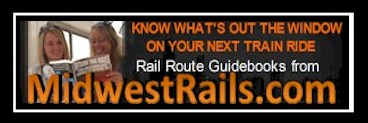The Amtrak Years
Written by the MIdwest Rail Rangers
E-mail: info@railrangers.org
This article is (c)2019 Midwest Rail Rangers Corporation. This website is operated for information purposes only and has no affiliation with any heritage railroad, Amtrak, Budd Company, or any other organization besides the Midwest Rail Rangers.
Amtrak assumed operations of most of the nation's intercity passenger rail system in May 1971 --- and, as a result --- got to hand-pick which lounge cars and other rolling stock they wanted to purchase or lease from the predecessor railroads. This acquisition by Amtrak included many different varieties of heritage lounge cars including full-length domes, half-domes, round-ended observation lounges, single-level lounge cars --- and even a handful of bi-level lounges that were built for the Santa Fe (these would go on to become the famed Pacific Parlour Cars). During the course of the 1970's, many of these lounge cars remained in service, but were re-painted in Amtrak's red, white, and blue paint scheme and re-numbered.
Heritage lounge cars acquired by Amtrak and converted to a modern head-end power system include, but are not limited to the following: #2500-2524 (25 single-level dormitory lounge cars built by Budd in 1949-1950), #3100-3105 (six single-level lounge cars built by the St. Louis Car Company in 1954), #3106-3127 (20 single-level lounge cars built by Budd in 1948-1952), #9300-#9302 (three dome lounge cars built by Budd in 1955), #9310-#9312 (three dome lounge cars built by Pullman-Standard in 1952), and #39970-#39975 (six bi-level lounge cars built by Budd in 1956 and used on Santa Fe's El Capitan between Chicago and Los Angeles).
Just a few years into its existence, Amtrak officials quickly realized the company would need many new passenger rail cars to keep rolling down the rails, including lounge cars. The new Amfleet I series was put into service along the east coast between 1975 and 1977. The order with Budd included 40 "Amclub" club cars that were built to be similar to traditional parlour cars. These cars had a snack bar in the center, 18 club seats in a 2-by-1 configuration, and 23 coach seats. These cars provided 'first class' service on select trains.
Amtrak later referred to these as "Split Amclubs". Club cars rebuilt with all-club style seating were called "Full Amclubs". (It should be noted that none of the "Amclubs" remain in their original configuration today). Three of the original club cars were delivered with all club-style seating for a total of 33 seats; five of the original style were rebuilt to match. As the original Metroliners were withdrawn, many of the "Amclubs" were refurbished for use in Metroliner service. Three were rebuilt for use on the Montrealer; booths and lounge seating replaced the coach seating and club seats. These were later rebuilt as all-table dinettes. Most clubs were rebuilt as club-dinette cars, with one half given over to booths and the other having 2-by-1 seating. Others were rebuilt as full-length business class cars, with 62 seats. Still others were converted to 72-seat coaches.
When it came to new equipment to be used on western routes, Amtrak officials decided to go with a bi-level design --- a move that was inspired by the Santa Fe's Hi-Level equipment. The initial design phase for what would become Amtrak's Superliner fleet launched in 1973. However, it was not until between 1978 and 1981 that Amtrak received the newly-built cars from Pullman-Standard. Superliners were built to be pulled at speeds of up to 100 mph; the cars measure 85 feet long, were approximately 10 feet wide and 16 feet high, and weighed 160,000 pounds. The stainless steel exteriors feature fluting gave the lounge cars a sleek, aerodynamic appearance. A reporter for Amtrak NEWS described the cars' "subdued" color scheme of browns, beiges and greys, noting that "seat upholstery is inspired by designs of the Southwestern Indians." Interiors were carpeted on both floors and side walls to dampen sound and provide a quiet atmosphere.
The 25 Superliner Sightseer lounge cars were among the last cars in the initial Superliner order to be built and put into service, finally arriving in late 1981 (this order also included 150 coaches, 70 sleepers, and 39 diners). The Superliner I Sightseer Lounge Cars, which were numbered #33000 to #33024, has windows that wrapped upward into the ceiling, which providing lateral views of the scenery along the train's route. The upper level originally contained all swivel chairs and had a lounge area in the middle with a wet bar. The lower level contains a bathroom, additional tables, and a snack bar. As built, the lounges had seating for 73. The cars were built with an electric piano in the lower level, which has since been removed in all cars.
Rail passengers seemed to enjoy the amenities provided aboard the Superliner I Sightseer Lounge Cars on such routes as the Empire Builder and Southwest Chief in the very early 1980's. However, the double-decker cars' incompatibility with single-level heritage lounge cars (unless they were connected to a special 'transition sleeping car') spelled the demise for many of the traditional full dome cars and half dome cars on train routes in the western United States. Some heritage lounge cars were moved to eastern routes, where they remained in use for several more years, since they were compatible with single-level heritage equipment and Amtrak's then-relatively new Amfleet cars.
In the early 1990's, Amtrak ordered nearly an additional 195 Superliner cars from Bombardier Transportation, which had acquired the Superliner patents after Pullman-Standard closed its door. This new order of Superliner II railcars included 25 Sightseer Lounge Cars built from scratch. They were built in pretty much the same configuration as the Superliner I order. Numbered #33025 to #33049, the new loungers were put into service on such Amtrak routes as the City of New Orleans, Capitol Limited, and the Auto Train --- which would also now feature bi-level equipment.
During the late 1990's and early 2000's, all Superliner Lounge Cars would go through various stages of refurbishment. The biggest changes included the addition of booths on one-third of the car upstairs --- and a reconfiguration of the lower level snack-bar which let passengers actually "walk-in" to the snack bar area.
By the time the new millennium rolled around in 2000, almost all of Amtrak's heritage lounge car inherited from legacy railroads had been retired. All Amtrak long-distance trains that operated to/from New York City featured an Am-fleet lounge car --- these were single-level cars built in the late 1970's that were re-configured to have all-table seating on both sides of a snack bar, which was located in the middle of the car. All other long-distance trains that did not operate to/from New York City featured Sightseer Lounge Cars.
One of rare exceptions to what was written above included five hi-level heritage lounge cars called "Pacific Parlour Cars" that operated as a lounge car just for first class passengers on the Coast Starlight between Los Angeles, California and Seattle, Washington.
After the Pacific Parlour Cars were pulled out of service in February 2018, Amtrak's last surviving dome car "Ocean View", became the railroad's last surviving heritage lounge car by default. "Ocean View" was used for business travel by Amtrak executives and on special excursion trains, such as in Maine and New York State. "Ocean View" did not hold the title for very long either... as it was pulled from service on November 2, 2018... and sent to long-term storage in April 2019. This decision really marked the end of an era --- no more heritage lounge cars are currently in use on Amtrak.
In recent years, the pattern of single-level Am-fleet cars being used as lounge cars on long-distance trains going into New York City --- and Superliner bi-level Sightseer Lounge cars being used on other long-distance train not going into New York City has continued --- at least for the most part.
Ironically, the same round of cutbacks at Amtrak that took place in 2018-19 which resulted in the retirement of the Pacific Parlour Cars and "Ocean View" as lounge cars... also created new lounge cars opportunities for sleeping car passengers on two eastern long-distance routes. Traditional dining cars on the Lake Shore Limited (Chicago-New York/Boston) and the Capitol Limited (Chicago-Washington, D.C.) were converted into first class diner/lounge hybrid cars when Amtrak decided to launch it's "fresh and contemporary" food program.
As of the last update of this article (May 2019), sleeping car passengers can use the new Viewliner II dining car anytime they want on the Lake Shore Limited; both dining and lounge space are one in the same. The same applies to the modified Superliner Dining Car (called a "Cross Country Cafe Car") on the Capitol Limited. This program has cut dining car staff by about two-thirds and provides far less warm meal options than before... however it does create a lounge car on two routes that previously did not have much lounge space.
What will the future of the lounge car face at Amtrak as the railroad approaches its 50th Birthday in 2021? Stay tuned...
This page is maintained by the Midwest Rail Rangers. If you enjoyed the content, please consider making a donation to our 501(c)(3) non-profit organization. Click the link below; even the smallest amounts help our research, web design, and domain hosting.



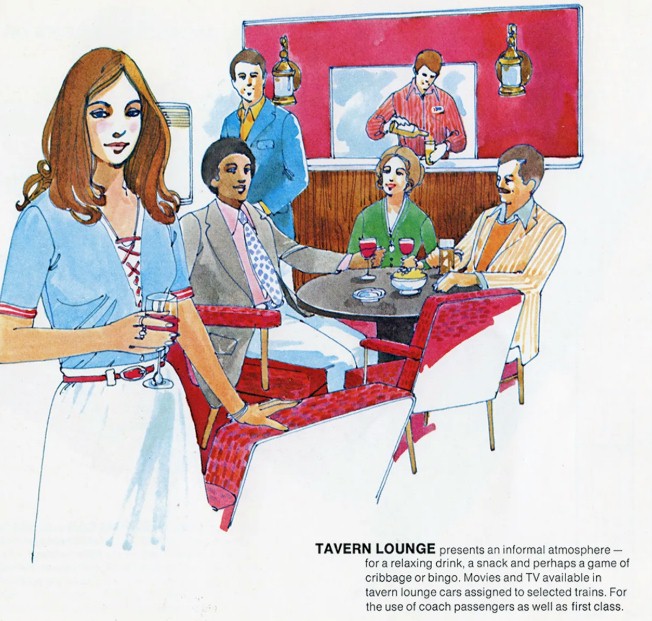
Amtrak inherited many heritage lounge cars, including domes and round-end observation cars, from the legacy railroads upon its founding in 1971.

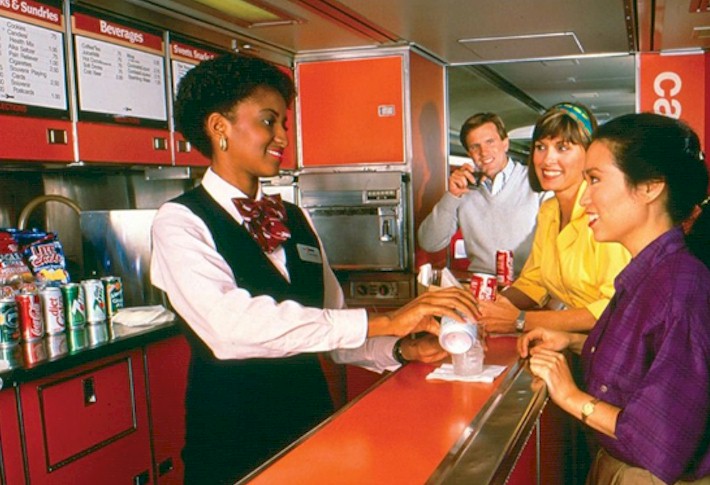

These cars represent some of the first lounge cars specifically built for Amtrak; they came into service in the mid-to-late 1970's.
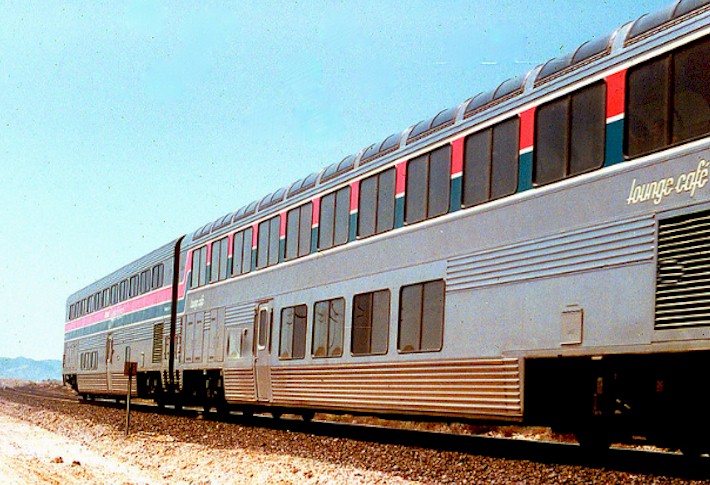
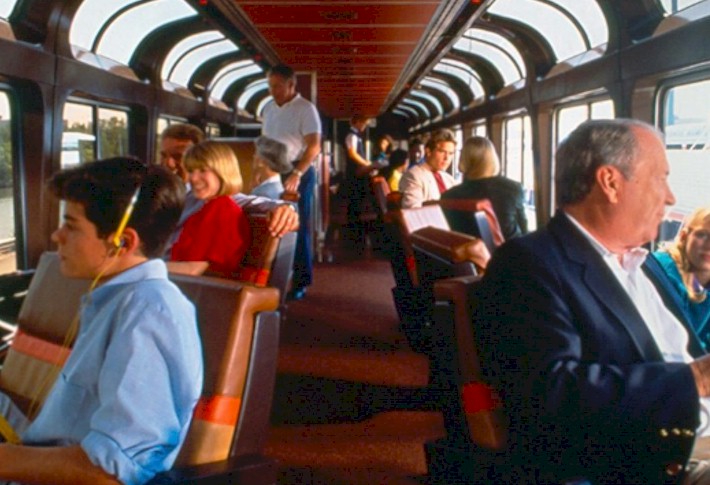

Amtrak's Superliner I Sightseer Lounge Cars were introduced in the early 1980's on mainly long-distance train routes in the western U.S.

Amtrak blueprints for the re-build of the upper level of a Sightseer Lounge car that took place in the mid-1990's; note that swivel chairs were replaced with booths and tables at one end of the car.
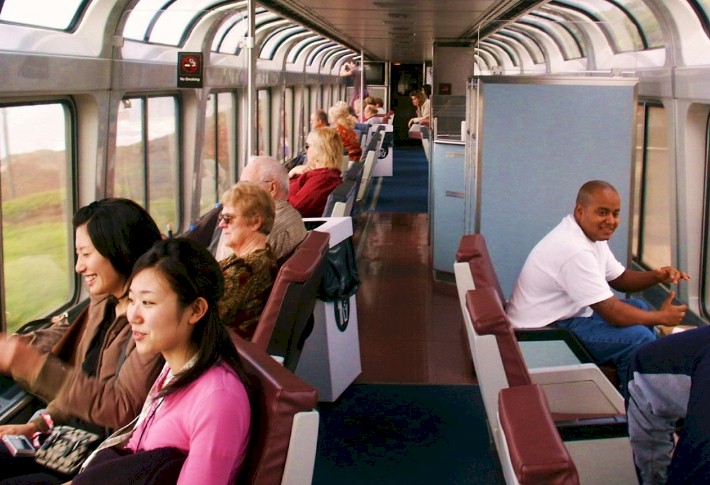
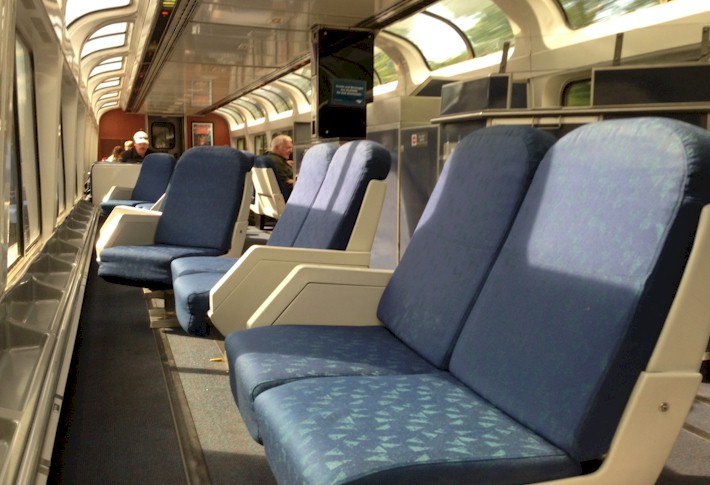

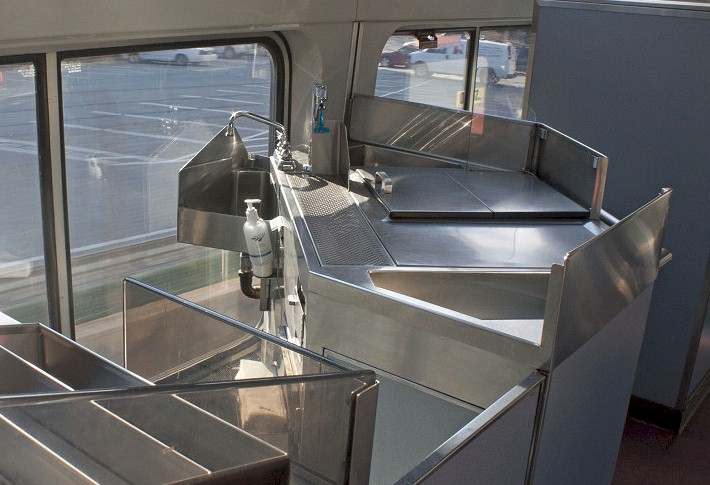
A look at the upper level of an Amtrak Sightseer Lounge Car after the mid-1990's re-build to add booths and tables to one end of the cars.
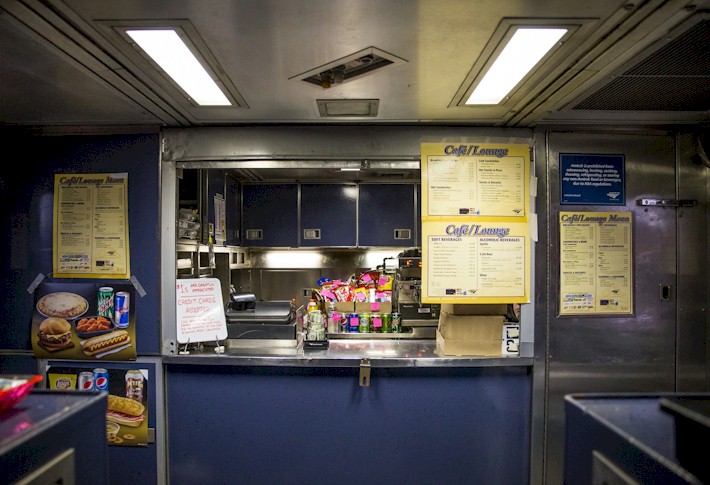
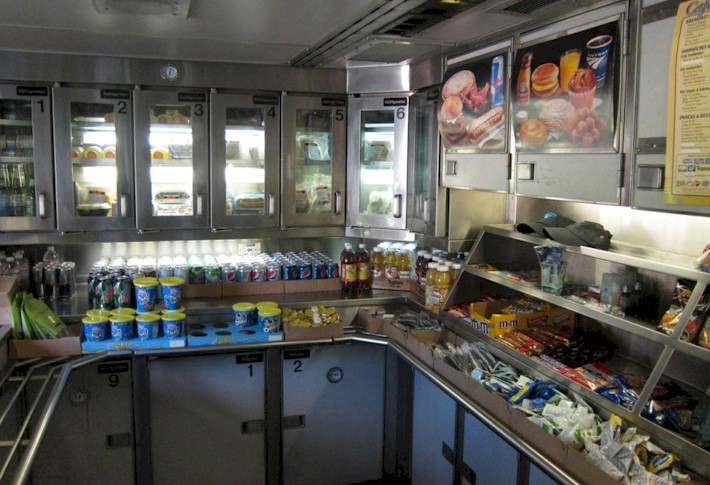
The downstairs of Amtrak's Sightseer Lounge Car also received a make-over in the mid-1990's; the window where you would order snacks was replaced with a walk-in area.
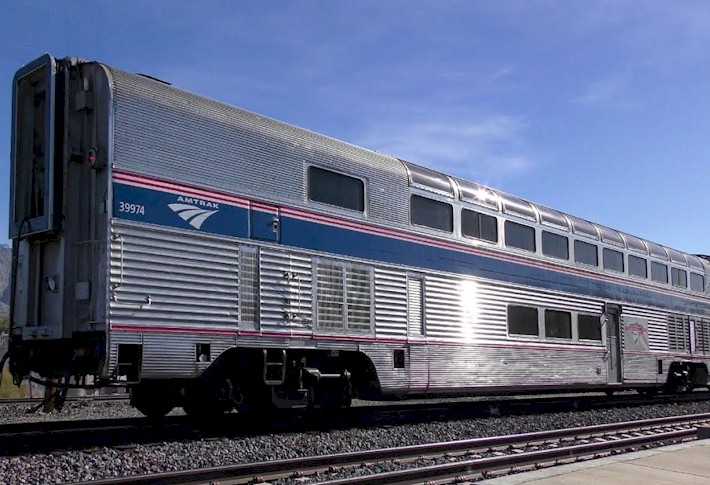
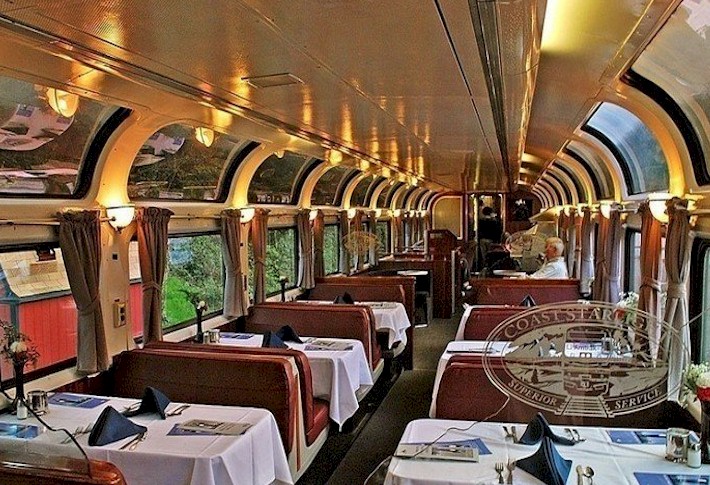
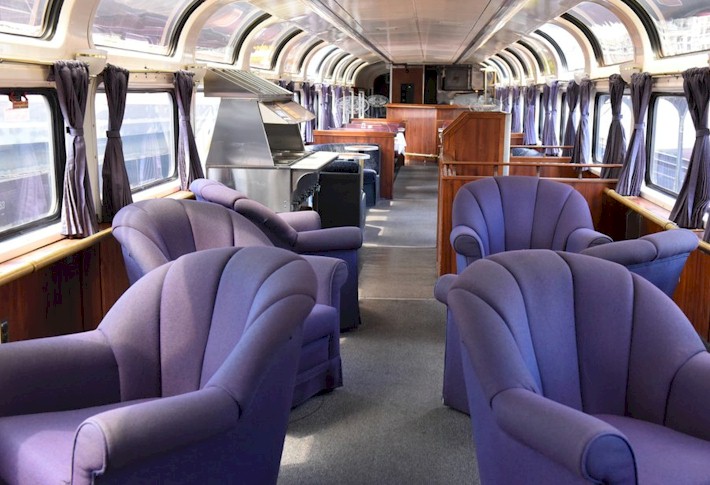
Amtrak's Pacific Parlour Cars served as a special First Class Lounge for passengers on the Coast Starlight until they were removed from service in February 2018 and subsequently sold off to private owners. These were former Santa Fe Hi-Level Lounges built in 1956 by the Santa Fe.

The last heritage lounge car used by Amtrak was it's last surviving dome car "Ocean View". It was last used in revenue service on November 2, 2018. On April 14, 2019, it was sent to Chicago and put in long-term storage.
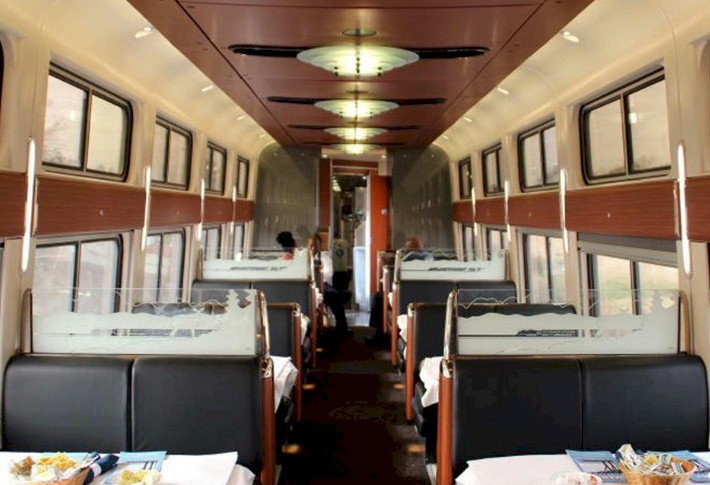
Amtrak spent a lot of money to create view Viewliner II dining cars (as pictured above) in 2017. They were supposed to be used as traditional dining cars, however changes to the food service on the Lake Shore Limited route has turned them into essentially a hybrid diner/lounge car for passengers who are traveling between Chicago and New York/Boston.

